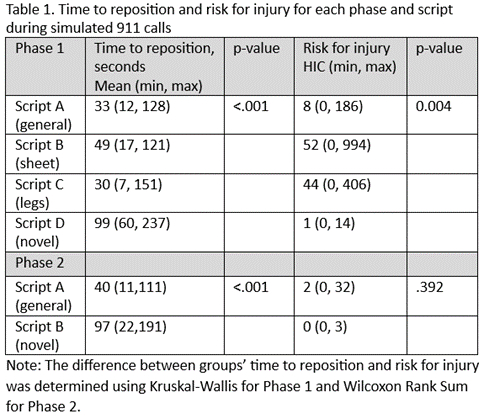Final ID: Su604
Telecommunicator Guided Repositioning to the Floor During Out-of-Hospital Cardiac Arrest
Abstract Body: Background: Current guidelines advise people to reposition a patient in need of cardiopulmonary resuscitation (CPR) to a firm surface. Repositioning is associated with longer time to first compression and a lower likelihood of bystander CPR. Older adults often have comorbidities that increase the risk for injury during repositioning.
Aims: The aim of this research was to develop and evaluate the quality of a novel telecommunicator-CPR (TCPR) repositioning intervention.
Methods: This study was conducted in two phases that employed a biomechanical surrogate containing head sensors. In Phase 1, our novel intervention was tested against three other TCPR scripts (A-general instructions, B-using sheet, C-pulling legs). Participants completed simulated 911 calls with all four scripts and were randomized to the order they completed them. The primary outcome was time to reposition, and the secondary outcome was risk for injury, determined by the head injury criterion (HIC). The novel intervention script (D) was revised based on feedback from participants and video review. In Phase 2, our revised TCPR intervention was tested against script A with participants randomized to either script received. The difference between groups’ time to reposition and risk for injury was determined using Kruskal-Wallis for Phase 1 and Wilcoxon Rank Sum for Phase 2.
Results: Phase 1 had 35 participants, were 60% female with a mean (M) age of 45 years (19 SD) and 94% reported exercising weekly. One participant was unable to reposition the manikin to the floor using scripts A or B. Time to reposition was shortest for script C (M= 30 secs) and longest for novel script D (M= 99 secs, p<.001, Table 1). Risk for injury was highest for script B, using the sheet, and lowest for novel script D, p=0.004. Phase 2 had 36 participants, were 56% were female with a mean age of 45 (18 SD). Time to reposition was shorter for script A, general instructions (p<.001), and risk for injury was similarly very low in both scripts A and D (Table 1).
Conclusions: Findings suggest use of a sheet or pulling on legs may increase the risk for injury and needs further study. General instructions, which allow the bystander to determine the best approach, had the shortest time to reposition while maintaining a low risk of injury. Our novel script resulted in the longest time to reposition but had a low risk of injury. Further study is warranted to test whether the time to deliver instructions could be shortened.
Aims: The aim of this research was to develop and evaluate the quality of a novel telecommunicator-CPR (TCPR) repositioning intervention.
Methods: This study was conducted in two phases that employed a biomechanical surrogate containing head sensors. In Phase 1, our novel intervention was tested against three other TCPR scripts (A-general instructions, B-using sheet, C-pulling legs). Participants completed simulated 911 calls with all four scripts and were randomized to the order they completed them. The primary outcome was time to reposition, and the secondary outcome was risk for injury, determined by the head injury criterion (HIC). The novel intervention script (D) was revised based on feedback from participants and video review. In Phase 2, our revised TCPR intervention was tested against script A with participants randomized to either script received. The difference between groups’ time to reposition and risk for injury was determined using Kruskal-Wallis for Phase 1 and Wilcoxon Rank Sum for Phase 2.
Results: Phase 1 had 35 participants, were 60% female with a mean (M) age of 45 years (19 SD) and 94% reported exercising weekly. One participant was unable to reposition the manikin to the floor using scripts A or B. Time to reposition was shortest for script C (M= 30 secs) and longest for novel script D (M= 99 secs, p<.001, Table 1). Risk for injury was highest for script B, using the sheet, and lowest for novel script D, p=0.004. Phase 2 had 36 participants, were 56% were female with a mean age of 45 (18 SD). Time to reposition was shorter for script A, general instructions (p<.001), and risk for injury was similarly very low in both scripts A and D (Table 1).
Conclusions: Findings suggest use of a sheet or pulling on legs may increase the risk for injury and needs further study. General instructions, which allow the bystander to determine the best approach, had the shortest time to reposition while maintaining a low risk of injury. Our novel script resulted in the longest time to reposition but had a low risk of injury. Further study is warranted to test whether the time to deliver instructions could be shortened.
More abstracts on this topic:
Adapting Chest Compressions to Variable Chest Dynamics in Out-of-Hospital CPR
Uriguen Jose Antonio, Leturiondo Mikel, Daya Mohamud, Russell James
Airway Opening Index is Associated with Return of Spontaneous Circulation in Swine and Humans with Cardiac ArrestBhandari Shiv, Coult Jason, Sharpe Zachary, Rea Thomas, Neumar Robert, Hsu Cindy, Counts Catherine, Sayre Michael, Johnson Nicholas

